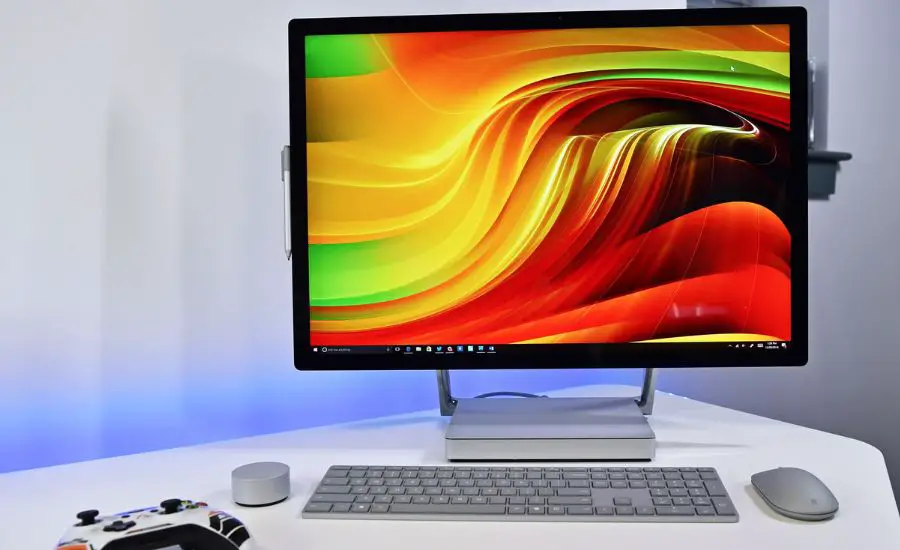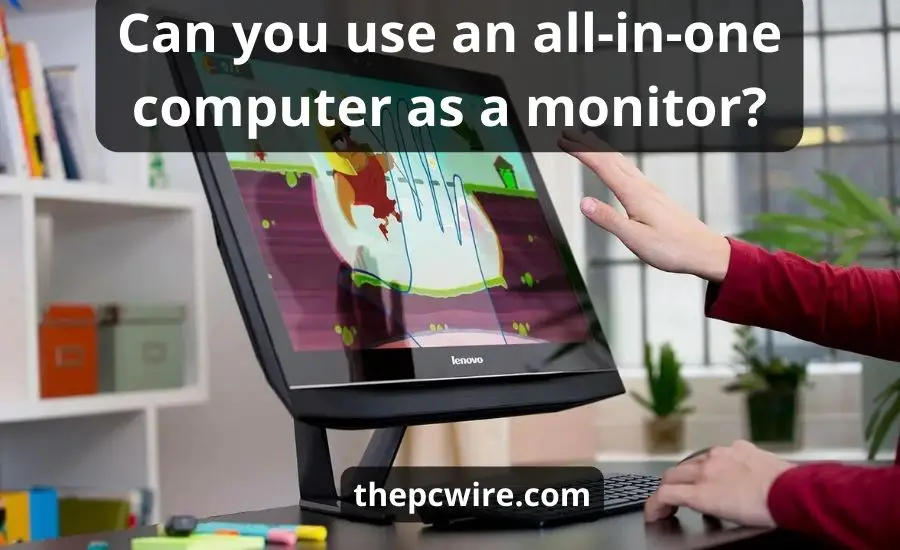Can you use an all in one computer as a monitor? When considering the possibility of using an all-in-one main computer, it’s essential to explore the functionalities and capabilities of the main computer itself.

While the primary purpose of an all-in-one computer is to integrate various components into a single unit, understanding its capacity to function as a monitor for another device, such as a separate computer, hinges on the availability and compatibility of specific features, notably the display input ports.
Let’s delve into the nuances of this scenario to determine the feasibility and practicality of using an all-in-one computer in this manner.
Exploring display input ports
When exploring display input ports on your device, it’s crucial to understand the range of connectivity options available.
The display in port, often found on AIO computers, allows external devices to use the all-in-one display.
USB ports provide versatility, supporting USB video adapters that enable connections to various display ports.
HDMI ports are standard for high-definition video and audio transmission.
VGA in ports, while older, still find use and may require adapters for compatibility.
Checking the available video ports ensures seamless connections, enabling you to choose the right cable or adapter for your specific needs and devices.
What adapters can I use?
When exploring the adapters you can use to connect devices, it’s essential to consider the available ports on both your computer and the monitor.
If your HP computer features an HDMI port and the monitor has a DisplayPort, you can use an HDMI to DisplayPort adapter to establish the connection.
Similarly, if your computer lacks a specific display port that your monitor supports, USB video adapters provide a versatile solution.
These adapters enable connectivity between USB ports on your computer and various display ports on the monitor.
Additionally, some all-in-one computers come equipped with an HDMI-in port, allowing you to use the display as a monitor for other devices with HDMI output.
Moreover, if your computer or monitor is equipped with a VGA in port, you may need a VGA adapter for compatibility.
This ensures that your connectivity solution aligns with the available ports on both devices, enabling a seamless and functional connection.
Before making a selection, ensure compatibility with the specific ports available on your computer and the monitor, as not all computers support every type of adapter.

How do you connect an external monitor to your HP all-in-one desktop computer?
Examine the back or sides of your HP all-in-one device to locate the accessible ports.
Unlike a standard desktop computer with a dedicated monitor port, all-in-one devices may have various input options, including HDMI, DisplayPort, or USB-C.
Depending on the identified port on your HP all-in-one, choose the appropriate cable.
If it has HDMI, use an HDMI cable; if it has DisplayPort or USB-C, select the corresponding cable. Ensure the cable is compatible with both your all-in-one and the monitor.
Plug one end of the selected cable into the appropriate port on your HP all-in-one and the other end into the corresponding port on the monitor.
Turn on the monitor and make sure it’s set to the correct input source. This may involve using the monitor’s on-screen menu to select the input connected to your HP all-in-one.
On your HP all-in-one, navigate to settings. In Windows, right-click on the desktop, select Display settings, and configure the multiple display options, such as extending or duplicating the screen.
Fine-tune the screen resolution settings to ensure optimal display quality. This can also be done in the settings menu on your HP all-in-one.
In some cases, a restart may be required for the changes to take effect. Restart both your HP all-in-one and the monitor if needed.
By adhering to these instructions, you can effortlessly link a monitor to your HP all-in-one desktop computer, elevating your display functionalities for enhanced productivity or entertainment.

By using HDMI cable
Connecting your all-in-one computer to an external display is made simple by using an HDMI cable.
Locate the HDMI out port on your all-in-one main computer, typically found on the back or side.
Connect one end of the HDMI cable to this port.
On the other end, plug the HDMI cable into the HDMI input port of your external display.
Additionally, some external displays may require an input switch to detect the connected HDMI signal properly.
This single cable not only transmits high-definition video but often includes audio as well, streamlining the connection process and ensuring a crisp and clear display on your monitor or TV.
With the ubiquity of HDMI technology, it’s a convenient and widely compatible solution for expanding your display setup.
By using display in port
Using the display in port on your all-in-one computer offers a straightforward method for extending your display capabilities.
Locate the display in port on your all-in-one device, typically situated among other input and output ports.
Connect one end of the appropriate cable to this port.
The other end of the cable should be connected to the output port of the device you want to use as an additional display.
Once connected, navigate to your computer’s settings and configure the display mode to extend your desktop.
This method allows you to seamlessly integrate another device into your workflow, providing a versatile and efficient solution through a simple input port linkage.

By using VGA output
Connecting a secondary monitor to your all-in-one computer is possible through a VGA connection.
Identify the VGA port on your all-in-one device, often found among the array of input and output ports.
Use a VGA cable by connecting it from the port on your all-in-one computer to the VGA in port on your secondary monitor.
This analog connection allows you to extend your desktop or mirror your display, providing a reliable solution for those with monitors that support VGA connectivity.
While VGA is an older technology, it remains a practical option for expanding your screen real estate and creating a dual-monitor setup with your all-in-one computer.
By using DVI
Extending your display configuration by adding another monitor to your all-in-one computer is achievable through a DVI connection.
Locate the DVI port on your all-in-one computer and connect one end of a DVI cable to it. The other end should be connected to the DVI port on your secondary monitor.
This digital connection ensures high-quality video transmission between devices.
Once connected, access your computer’s settings to configure how you want to use the additional monitor – whether to extend your desktop for increased workspace or mirror your primary computer display.
The use of a DVI cable provides a reliable and straightforward method for enhancing your viewing experience with an extra display.

Issues you might face and their solutions
When setting up additional displays on your all-in-one primary computer, you may encounter a few common issues and their solutions.
If using a USB port for display, ensure that your system supports a USB video adapter.
For display cables like HDMI, check the cable for damage and verify that both the HDMI port on the computer and the input port on the monitor are functioning correctly.
In cases of wireless display, ensure that your all-in-one computer and the external device are on the same network, and troubleshoot any connectivity issues.
If you’re facing difficulties configuring the additional display settings, make sure the graphics drivers are up-to-date, and consult your computer’s user manual for guidance.
Finally, if using an out port, such as HDMI out, ensure the cable is firmly connected and that the external display is set to the correct input source.
Addressing these issues methodically can help you achieve a seamless multi-display setup.
Using an all-in-one computer as a monitor with remote desktop software
Transforming your all-in-one computer into a second monitor is achievable through remote desktop software.
By leveraging this technology, you can extend your primary computer’s display onto the all-in-one, effectively turning it into a second monitor.
Please make sure both devices are connected to the same network, install the remote desktop software on both machines, and follow the setup instructions.
This approach provides a convenient and wireless solution for using your all-in-one as an additional display, seamlessly and efficiently adjusting the necessary additional display settings to enhance your computing experience.

Disadvantages of using an all-in-one computer
All-in-one PCs, while compact and convenient, come with certain disadvantages. One notable limitation is the lack of upgradeability commonly found in traditional desktops.
As these systems integrate components into a single unit, upgrading specific hardware, such as the graphics card or processor, can be challenging.
Additionally, if a specific component fails, it may require servicing the entire unit. The limited number of available ports, particularly output ports, can also be a drawback, restricting the connectivity options for external devices.
This limitation may impact users who require extensive peripheral connections or specialized hardware configurations.

Returning to the PC mode
Returning to PC mode on your all-in-one primary computer involves adjusting the PC projection settings to revert to a standard display configuration.
Navigate to the settings on your all-in-one PC, where you can find options for changing the display mode.
Select the appropriate mode, typically labeled as “PC mode” or a similar term, to switch back to the standard configuration.
This step is useful if you have previously used your all-in-one PC as a secondary monitor or in a different display mode.
By adjusting these settings, you can seamlessly transition your all-in-one PC back to its regular mode, optimizing it for individual use.

FAQ
Yes, you can use an all-in-one PC as a monitor only, depending on its capabilities.
Check for an “In” or “Display In” on the all-in-one, and use the appropriate display cable to connect it to another device’s out port.
If your Asus all-in-one computer has a designated Display In or HDMI input, you can use it as a monitor.
Simply connect another device, such as a laptop or desktop, to the Asus all-in-one using the appropriate cable, and configure the settings on both devices accordingly.
Similarly, if your Lenovo all-in-one PC supports a display input, you can use it as a monitor.
Identify the “Display In” or HDMI on the Lenovo all-in-one and connect it to another device using a compatible cable. Adjust the settings on both the Lenovo PC and the connected device as needed.
To do that, check if it has a “Display In” or HDMI port. If so, use the appropriate display cable to connect another device, such as a laptop or desktop, to your computer.
If your computer lacks the necessary input, you can explore using a USB video adapter to connect devices through a USB port.
Conclusion
In conclusion, the versatility of connecting an all-in-one computer to an external display opens up a world of possibilities for users seeking multiple displays.
Whether extending your desktop for enhanced productivity, enjoying full-screen videos, or using your all-in-one as a secondary monitor for your main computer, the seamless connectivity through various video input options, such as HDMI, enhances the overall computing experience.
This capability allows users to tailor their setup to suit specific needs, providing a dynamic and flexible approach to computing that adapts to different tasks and preferences.
As technology continues to evolve, the ability to connect video sources effortlessly contributes to a more integrated and efficient computing environment.

Hi, this is Masab, the owner and founder of the PC Wire. I’m a PC enthusiast who loves to talk about computers. I have been testing PC hardware for several years now, and I hope my knowledge would answer your queries thoroughly.

